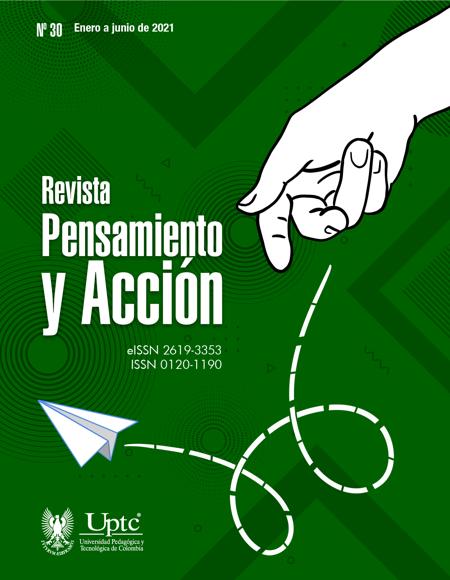Teaching the Concept of pH from the Perspective of Scientific Thinking: An Exploratory Systematic Review

Abstract
The objective of this article was to carry out an exploratory systematic review, in order to identify which teaching strategies have addressed the concept of pH at different school levels, from the perspective of scientific thought. For this, an information search was carried out in the Web of Science (WoS) and Google Scholar databases; the time interval was from 2010 to October 2020, identifying 17 documents, of which only 8 were related to the research topic. Subsequently, an analysis was carried out to identify if these were congruent with scientific thinking skills: asking questions, describing facts, establishing models and arguing. As a result of this review, it was identified that didactic strategies of an experimental type are the most popular ones. For the most part, the concept is approached from topics such as natural indicators, in other cases, electronic devices and software are used, which allow developing skills not only in the scientific field, but also in technology and mathematics. In all cases, there is an affinity for conducting experiments, mainly of the home type. Likewise, the abstract and material representations that students can develop by participating in these activities are analyzed. Another important aspect that must be strengthened is the argumentation and the correct appropriation of the concept, according to its current definition.
Keywords
chemistry, pH, scientific thinking, teaching
References
Blanchar, F. (2020). Características de la práctica pedagógica en el área de Química Characteristics of pedagogical practice in the chemical area Características da prática pedagógica na área química. Revista Científica, 37(1), 30-57. https://doi.org/10.14483/23448350.14855
Burbano, C., Builes, Y., y Coronado, J. (2020). Habilidades de pensamiento científico mediante experimentos sencillos en estudiantes de segundo de primaria. Revista de La Asociación Colombiana de Ciencias Biológicas, 32, 31-41
Chamizo, A. (2017). Habilidades de pensamiento científico (U. A. de México (ed.); Primera Ed).
Costa, S., y Fernandes, J. (2019). Listening to pH. Journal of Chemical Education, 96, 372-376. https://doi.org/10.1021/acs.jchemed.8b00641
Delgado, P., Durand, A., Zegarra, P., Jiménez, H., Alvarez, V., y Vena, G. (2020). Bioremedicación de cromo VI mediante el uso de Rhodopseudomonas palustris en efluentes industriales provenientes de curtiembres. Revista Boliviana de Química, 37(1), 21-27. https://doi.org/10.34098/2078-3949.37.1.3
Dotel, S., Pozo, P., José, C., y Rodríguez, Y. (2019). Evaluación de la acidez en vinagres comercializados en la República Dominicana. Ciencia, Ambiente y Clima, 2(2), 43-52. https://doi.org/10.22206/cac.2019.v2i2.pp43-52
Fliegel, L. (2020). Role of pH Regulatory Proteins and Dysregulation of pH in Prostate Cancer. En: Reviews of Physiology, Biochemistry and Pharmacology. https://doi.org/10.1007/112_2020_18
Hernández, D., y Astudillo, L. (2014). Titulaciones ácido-base con el empleo de software. Educacion Quimica, 25(1), 42-45. https://doi.org/10.1016/s0187-893x(14)70522-1
Herrera, S., Gómez, L., y Cabrera, P. (2020). Influencia del uso de carbonato de calcio (CaCO3) en la alcalinización y sedimentación del jugo de caña. Revista Centro Azúcar, 47(3), 70-82
Jiménez, J. (2016). Los mapas mentales como estrategia matecognitiva inmersa en la metodología ABP para la enseñanza y el aprendizaje del concepto de pH [Tesis de Maestría]. Universidad Nacional de Colombia, Manizales, Colombia.
Jiménez, M., Salmerón, E., y Martínez, M. (2018). Chewing Gum and pH Level of the Mouth: A Model-based Inquiry Sequence to Promote Scientific Practices. World Journal of Chemical Education, 6(3), 113-116. https://doi.org/10.12691/wjce-6-3-2
Joglar, C., Rojas, S., y Manzanilla, M. (2019). Formulación y Uso de las Preguntas en la Clase de Ciencias Naturales a Partir de las Creencias de los Profesores. Un Estudio en la Región Metropolitana de Santiago, Chile. Información Tecnológica, 30(5), 341-356. https://doi.org/10.4067/s0718-07642019000500341
Johnstone, A. (1982). Macro and micro chemistry. School Science Review, 64(227), 377–339.
Lunelli, B., y Scagnolari, F. (2009). pH Basics. Science and Education, 86(2), 1–5.
Maleki, R., Khoshoei, A., Ghasemy, E., y Rashidi, A. (2020). Molecular insight into the smart functionalized TMC-Fullerene nanocarrier in the pH-responsive adsorption and release of anti-cancer drugs. Journal of Molecular Graphics and Modelling, 100, 1-29. https://doi.org/10.1016/j.jmgm.2020.107660
Mccarty, C., y Maynard, J. (2006). pH Paradoxes : Demonstrating That It Is Not True That pH ≡ -log [ H+]. Journal of Chemical Education, 83(5), 752-757. https://doi.org/10.1021/ed083p752
Moreno, M. (2013). Aprendizaje sobre disoluciones reguladoras de pH mediante indagación guiada utilizando sensores. Enseñanza de Las Ciencias, 31(1), 189-211
Pérez, E. (2016). Control de calidad en aguas para consumo humano en la región occidental de Costa Rica. Revista Tecnología En Marcha, 29(3), 3. https://doi.org/10.18845/tm.v29i3.2884
Quiroga, J. (2017). Estrategia didáctica para la enseñanza del concepto de pH mediante experiencias en el laboratorio con materiales contextualizados [Tesis de maestría]. Universidad Nacional de Colombia, Bogotá D.C., Colombia.
Rincón, H. (2013). Propuesta didáctica para el aprendizaje del concepto de pH en estudiantes de básica secundaria [Tesis de maestría]. Universidad Nacional de Colombia, Bogotá D.C., Colombia.
Rojas, S. (2018). Aprendizaje activo en la enseñanza del concepto de pH a través del estudio del suelo [Tesis de maestría]. Universidad Nacional de Colombia, Manizales, Colombia.
Savic, L., Schobert, I., Peters, D., Walsh, J., Laage, F., Hamm, C., Tritz, N., Doemel, L. A., de Lin, M., Sinusas, A., Schlachter, T., Duncan, J., Hyder, F., Coman, D., y Chapiro, J. (2020). Molecular imaging of extracellular tumor pH to reveal effects of locoregional therapy on liver cancer microenvironment. Clinical Cancer Research, 26(2), 428-438. https://doi.org/10.1158/1078-0432.CCR-19-1702
Tortosa, M. (2013). Aprendizaje sobre disoluciones reguladoras de pH mediante indagación guiada utilizando sensores. Enseñanza de Las Ciencias, 1(31), 189-211
Urquizo, E., y Sánchez, N. (2019). Extracto del maíz morado como indicador químico. Revista de Ciencias Sociales y Humanidades, 9, 92-104. https://doi.org/10.37135/chk.002.09.08
Val, O. (2020). Estudio de sustancias naturales como indicadores de pH: Una propuesta didáctica. Anales de Química, 116(2), 88-98
Villasis, M., Rendón, M., García, H., Miranda, M., & Escamilla, A. (2020). La revisión sistemática y el metaanálisis como herramientas de apoyo para la clínica y la investigación. Revista Alergia México, 67(1), 62. https://doi.org/10.29262/ram.v67i1.733
Webster, J., y Eren, H. (2014). Measurement, Instrumentation, and Sensors (Segunda Ed). Taylor & Francis Group.
Wunderli, S. (2020). Reference Materials in Measurement and Technology. In S. Medvedevskikh, O. Kremleva, I. Vasil’eva, & E. Sobina (Eds.), Reference Materials in Measurement and Technology (p. 251). Springer International Publishing. https://doi.org/10.1007/978-3-030-32534-3